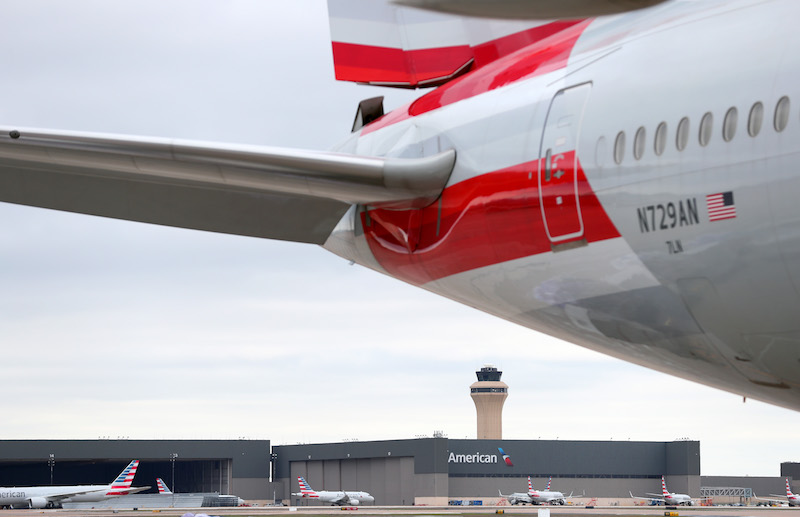
American Airlines went deep into debt while spending $15 billion on buybacks.
Image: Photo by Tom Pennington/Getty Images
The titanic coronavirus stimulus package, if it passes, comes with a condition for the businesses it bailed out: They can’t use taxpayer money to buy back shares of their own stock. Companies such as American Airlines, which spent $15 billion on buybacks in the past half-dozen years, and Boeing, which initiated $43 billion over the past decade, have earned notoriety for depleting their cash reserves through these moves and then telling the government they are broke and need help.
The prohibition is a popular one. Sen. Elizabeth Warren (D-Mass.) calls this practice a “sugar high for corporations” that “boosts [stock] prices in the short run” but destroys value over the long run. Other critics call it an “accounting trick” for corporate chieftains to enrich themselves and their shareholders at the expense of workers. Even President Trump offered this admonition: “I don’t want to give a bailout to a company and then have somebody go out and use that money to buy back stock in the company,” he said Sunday. “. . . So I may be Republican, but I don’t like that.”
Even businesses not participating in the bailout will be less likely to initiate stock buybacks in the coming months. In a depression, many simply won’t have the cash. And if they do, they’ll recognize the wisdom of building their reserves in an uncertain time. AT&T, JPMorgan Chase, Citigroup and McDonalds are among the corporations that since the outbreak have announced they are suspending their buyback programs.
Yet that means only a temporary pause in a practice that has flourished in corporate America: U.S. companies spent $1.09 trillion on buybacks in 2018, according to Winston Chua at TrimTabs, an asset management company. That was the highest on record, Chua said. The $900 billion companies spent in 2019 was the second-highest.
And unfortunately, the practice is toxic for working Americans. Between 2003 and 2012, companies in the S&P 500 devoted 54 percent of their earnings to buying their own shares (and an additional 37 percent to paying out dividends), according to a study by William Lazonick, an economist at the University of Massachusetts at Lowell. That left less than 10 percent for research and development, plant modernization, raises for workers, and other more productive uses of profits. It used to be that workers did well at corporations that did well. That’s no longer true, and buybacks are a big part of the reason.
For decades, stock buybacks were considered market manipulation and, if not quite outlawed, were strongly discouraged, says Lenore Palladino, an economist at the University of Massachusetts at Amherst. That changed in the deregulation sweep of the 1980s under Ronald Reagan. In 1982, the Securities and Exchange Commission loosened its definition of stock manipulation, opening the floodgates. What had been a frowned-upon activity that put a company at risk of an SEC investigation soon became standard practice.
Today, shareholders love buybacks, in which a company spends its profits to purchase more control of itself. The maneuver pushes up share prices — not because a company is killing it in the marketplace but because there are fewer shares to trade (less supply, higher cost). It also helps a company look better: A key measure used by analysts and investors is “earnings per share.” Dividing the same revenue by fewer shares makes this metric magically rise.
Chief executives love buybacks as well. The vast majority of their pay comes in the form of stock options and stock grants. Buybacks increase the value of the shares they’ve already earned and help them earn more. And CEO compensation is tied to share price, so they have good reason to push the value up any way they can.
But buybacks have become a major driver of income inequality and help explain why members of the top 0.1 percent (which includes most high-ranking corporate executives) “reap almost all the income gains, good jobs keep disappearing, and new employment opportunities tend to be insecure and underpaid,” as Lazonick put it in a 2014 Harvard Business Review study called “Profits Without Prosperity.” He argued that American workers were no longer prospering because companies no longer shared wealth with them.
Corporate executives are twice as likely to sell their own stock during scheduled buyback periods, according to research by Palladino. Some companies even borrow money to cover the costs of a buyback. “They really are the tip of the spear of how large corporations have operated for the benefit of the wealthiest shareholders and corporate insiders at the expense of everyone else,” Palladino says.
The Trump tax cut only accelerated the practice. Under the Tax Cuts and Jobs Act of 2017, the corporate tax rate fell 40 percent, from 35 percent to 21 percent. That meant a lot more cash in the coffers of the country’s biggest companies. When top executives and their political allies were selling the cut, they promised new investments in America and its people. Instead, stock buybacks reached a crescendo. Some companies didn’t even wait for Trump to sign the bill. The board of directors at Pfizer, which had already approved $6.4 billion in buybacks before the tax cut, authorized an additional $10 billion pre-signing. Also jumping the gun were Home Depot, which announced a $15 billion buyback, and Bank of America, which committed to a $5 billion buyback.
As they bought up stock, many companies failed to deliver on their promises to workers. By the end of 2018, Senate Democrats had assembled a list of companies that had put some of their tax savings toward buybacks while initiating layoffs. They included General Motors, Wells Fargo and JPMorgan Chase, which laid off hundreds of workers that year despite a $3.7 billion windfall from the tax cut. The company committed to more than $50 billion in buybacks in 2018 and 2019 before announcing that it was temporarily abandoning its repurchasing plan.
Still, it wasn’t until the country’s airlines fell on hard times this month that buybacks ignited a major public debate. The same day the news broke that the airlines had asked the federal government for more than $50 billion in loans, guarantees and cash grants, Bloomberg News reported that the major air carriers had spent 96 percent of their cash over the past decade on stock buybacks. American, for instance, went deep into debt while spending $15 billion on buybacks. All told, six of the country’s largest airlines approved roughly $47 billion in buybacks over the past decade, spurring outrage.
Members of Congress have offered a number of solutions to this problem. Senate Minority Leader Chuck Schumer and Sen. Bernie Sanders have been touting an idea to bar buybacks unless companies pay their workers at least $15 an hour, provide seven days of paid sick leave, and offer health-care and retirement benefits. Another bill (the Reward Work Act, introduced by Sen. Tammy Baldwin last March) and its House companion (introduced by Reps. Jesús García and Ro Khanna) would ban open-market stock buybacks and require public companies to allow their workers to elect one-third of their board members. Sen. Sherrod Brown’s proposal would have companies give their workers $1 for every $1 million spent on buybacks.
For the moment, though, there’s only a temporary freeze in buybacks. American workers are about to suffer the effects of an economic depression. The eventual recovery should help them, too, not just their bosses.
This essay is published in partnership with the nonprofit newsroom Type Investigations. Nina Zweig provided research assistance.

Long-time journalist Gary Rivlin is a reporter with Type Investigations.